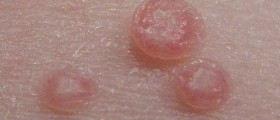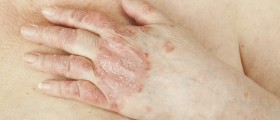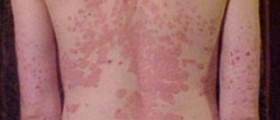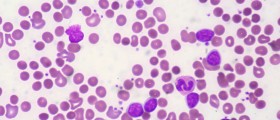Integumentary System
Integumentary system comprises of the skin, nails, and hair. It represents the largest organ in the human body. Apart from its amazing size integumentary system has lots of different roles and functions. It holds the water providing with proper hydration, it also assists in perspiration when human body temperature is increased, it is a barrier for numerous infective agents and so on.
Due to this system we can touch and feel many sensations such as cold, hot, and pain. The integumentary system additionally participates in the production of vitamin D. All in all, the purpose of this system is immense and fascinating.
Integumentary System Diseases
There are numerous diseases that affect the integumentary system. Still some of the most common include dermatitis, alopecia areata, psoriasis, warts, and athlete's foot.
Dermatitis is basically inflammation of the skin. It can be classified into many different types. Some of them are seborrheic dermatitis, atopic dermatitis, neurodermatitis, and so on. The symptoms of the disease include a rash that starts at one spot and then affects other parts of the body, itchiness, and swelling of the skin. Fortunately, this skin condition is not contagious and cannot be transmitted from one person to another.
Alopecia areata is classified as an autoimmune disease. This means that the body attacks its own cells not recognizing them. In alopecia body attacks hair on the scalp which results in baldness. At the beginning of the disease, only spots of the scalp are affected while during the progression of the disease entire hair can be lost.
Psoriasis is like alopecia areata an autoimmune disease. It is chronic and progressive and features specific scaly patches on the skin. These skin lesions are called psoriatic plaques and they may affect different parts of the body. Still, predisposing parts of the body include knees and elbows. These skin lesions are actually a place of inflammation and enhanced skin production.
Warts are small, round lumps that are found on the hands and feet. This medical condition is caused by the human papillomavirus. The typical appearance of warts resembles cauliflower and they are sometimes contagious meaning that they can be spread via contact. This bothersome disease usually goes away in a few months and there are effective treatments that may help patients to remove them for good.
Athlete's foot is a fungal infection of the feet. It features scaling and flaking. The condition is itchy as well. The fungi can be spread in moist areas and people can catch the infection in bathhouses if they share towels with other people and so on. Still, this condition can be successfully prevented by maintaining proper body hygiene.
- Several instruments have been developed to measure the quality of life in dermatology. The Skindex-29 instrument was developed in the United States by Chren et al. It has been validated in the American population in whom it demonstrated good measurement properties, as it was found to be internally consistent and replicable.
- A cross-sectional, non-interventional study was performed at 7 main and 34 smaller cities in Colombia. Due to the descriptive nature of the study, data of the percentage of patients' refusal to participate was not considered. Inclusion criteria corresponded to individuals older than 18 years, of any gender, and with any skin disease. Biopsy confirmation of skin disease was not mandatory. Eligible patients also had to express their willingness to participate in the study and had to fill out an informed consent.
- A total of 4340 questionnaires were sent to 29 Colombian dermatologists who agreed to participate as investigators and data monitors, and 2102 were returned. Of these, 206 were returned with incomplete data leaving a total of 1896 valid questionnaires for the analyses.
- The highest Skindex-29 scores were found in psoriasis (global median score: 35.3 symptoms: 38; emotions: 42.7 and function: 27.5); contact dermatitis (global median score: 32.1 symptoms: 37.9; emotions: 38.7 and function: 23); atopic dermatitis (global median score: 29.6 symptoms: 42.8; emotions: 34.3 and function: 18); urticaria (global median score: 34 symptoms: 33.9; emotions: 43 and function: 26.6); and condylomas or anogenital warts (global median score: 38.2 symptoms: 31.1; emotions: 47.7 and function: 34.4).
- The majority of interviewed patients were of ages between 18 and 49 (68%). Such finding not only reinforces exhaustive previous work but is also very relevant in this study, as this is the age at which individual's productivity and labor could be more affected by an impaired QOL. Regarding other sociodemographic characteristics, more women participated in the study, a finding that is not unusual, as several studies have shown that women seek more frequently a dermatologist than men. But interestingly, statistical differences were only found in the function domain when both groups were compared. This result could be explained by differences in the kind of job performed either by men or women, as it could be hypothesized that this domain could be perceived more impaired by men, particularly when physical work is an important task in their jobs. Importantly, the majority of participants did not have a co-morbidity, a characteristic that if presented, might have influenced final QOL scores.
- According to our results, skin disease duration in the majority of participants was >1 year, a fact that could explain higher Skindex-29 scores particularly in patients with chronic cutaneous disorders. This result is consistent with previous reports which have demonstrated that QOL is more impaired in long-standing disease.
Apart from the previously mentioned integumentary system may be affected by so many other diseases. However, they are not as common as the previously mentioned ones.


















Your thoughts on this
Loading...